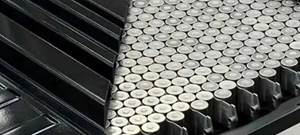European hydrogen orders announced by Hexagon Purus
Hexagon Purus is to deliver hydrogen distribution systems and mobile refueling stations for transportation and industrial applications by 2023.
Photo Credit: Hexagon Purus
(Ålesund, Norway) through its wholly owned subsidiary (Weeze, Germany), recently entered into two new order agreements for the company’s hydrogen distribution systems.
A follow-on order for hydrogen distribution systems and mobile refueling stations was received in September 2022 from ZE PAK Group (Wielkopolskie, Poland), said to be the region’s largest privately owned electricity producer.
The order is in conjunction with the two separate announcements in Hexagon Purus’ Q4 2021 presentation and a June 2022 announcement for hydrogen distribution systems and mobile hydrogen refueling stations. The value of the second follow-on order is approximately €6 million (approximately NOK 60 million). With this recent order, the total value of hydrogen systems being delivered by Hexagon Purus is reported to be €13 million (approximately NOK 130 million).
In November 2021, the Council of Ministers approved the Polish Hydrogen Strategy to the year 2030, with an outlook to the year 2040. The strategy sets out the main objectives and covers 40 actions for the development of a low-carbon hydrogen economy in Poland with an emphasis on the use of hydrogen in the energy, transport and industry sectors. Within transport, key 2030 goals include capacity for two-gigawatt electrolyzers, the rollout of 800-1,000 new fuel cell electric vehicle (FCEV) buses and the installation of a minimum of 32 hydrogen refueling stations.
“We are accelerating the development of our green hydrogen value chain in Poland,” Maciej Stec, vice president of the management board for strategy, Polsat Plus Group and member of the supervisory board of ZE PAK SA. “We recently received EU homologation for our hydrogen citibus, Nesobus. The successful tests of our hydrogen bus in four big Polish cities received positive feedback from the passengers and the authorities. We are happy we can speed up the transition to a hydrogen economy together with a reliable partner.”
The delivery of the hydrogen distribution systems and mobile refueling stations is scheduled from Q2 to Q3 2023.
Hexagon Purus has also entered into a framework agreement to deliver hydrogen distribution systems to a leading European green hydrogen producer. The company’s systems, including its Type IV hydrogen cylinders, will be used to deliver hydrogen for transportation and industrial applications in Europe. The minimum value of the framework agreement is approximately €9.7 million (approximately NOK 97 million).
“We are currently experiencing strong commercial momentum within our hydrogen distribution business following the recent push from European authorities to reduce emissions and increase energy security,” Michael Kleschinski, EVP of Hexagon Purus, says. “We are happy to play an important part in supporting European authorities’ ambitious growth plan for hydrogen adoption.”
Delivery of the hydrogen systems for this order is scheduled from Q4 2022 to Q4 2023.
Related Content
Update: THOR project for industrialized, recyclable thermoplastic composite tanks for hydrogen storage
A look into the tape/liner materials, LATW/recycling processes, design software and new equipment toward commercialization of Type 4.5 tanks.
Read MoreDevelopment of a composite liquid hydrogen tank for commercial aircraft
Netherlands consortium advances cryogenic composites testing, tank designs and manufacturing including AFP, hybrid winding, welding of tank components and integrated SHM and H2 sensors for demonstrators in 2025.
Read MoreComposites end markets: New space (2025)
Composite materials — with their unmatched strength-to-weight ratio, durability in extreme environments and design versatility — are at the heart of innovations in satellites, propulsion systems and lunar exploration vehicles, propelling the space economy toward a $1.8 trillion future.
Read MoreComposites end markets: Batteries and fuel cells (2024)
As the number of battery and fuel cell electric vehicles (EVs) grows, so do the opportunities for composites in battery enclosures and components for fuel cells.
Read MoreRead Next
Next-gen fan blades: Hybrid twin RTM, printed sensors, laser shock disassembly
MORPHO project demonstrates blade with 20% faster RTM cure cycle, uses AI-based monitoring for improved maintenance/life cycle management and proves laser shock disassembly for recycling.
Read MoreUltrasonic welding for in-space manufacturing of CFRTP
Agile Ultrasonics and NASA trial robotic-compatible carbon fiber-reinforced thermoplastic ultrasonic welding technology for space structures.
Read MoreCeramic matrix composites: Faster, cheaper, higher temperature
New players proliferate, increasing CMC materials and manufacturing capacity, novel processes and automation to meet demand for higher part volumes and performance.
Read More












